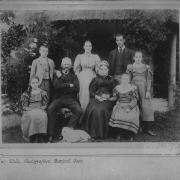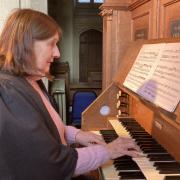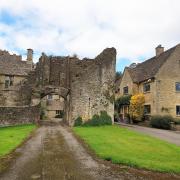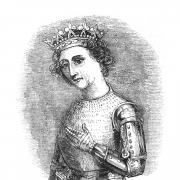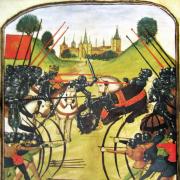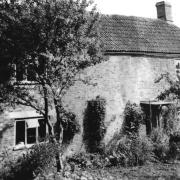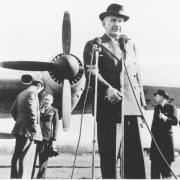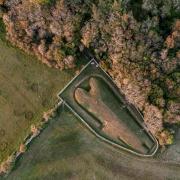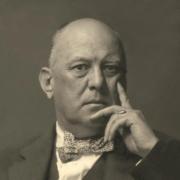The team at Gloucestershire Archives dust off the documents
Photograph of the Month
One hundred and ten years ago this month, the Stroud Show (returning on Saturday, July 16 after a two-year break due to Covid!) held a carnival on its second day on June 13, 1912. These are some photographs of the event. Back then it was known as the Stroud Agricultural Show and attracted huge crowds, typically 15-16,000 people. The carnival procession which went through Stroud’s streets was reported to be nearly a mile long! From left to right and top to bottom we have the following: the Workers Union float (which earned 3rd prize); Mr P. Ford as ‘an up-to-date lady’ (winner of the best fancy dress); some fancy dress competitors dressed as clowns, a policeman and Mr Punch(?) resting during judging; a group of donkeys and riders; more fancy dress competitors comprising ‘Weary Willie’, ‘Tired Tim’, ‘Countryman & wife’ and ‘A tramp’; some of the crowd; Mr E Towell as ‘Bibendum’, which is the original name for the ‘Michelin Man’ (1st prize for most original costume) and lastly Mr J Ball’s costermonger cart (first prize). The current Stroud Show reintroduced a carnival procession in 2020 – let’s hope this year’s is as good as the one in 1912!

Spotlight on Maps
By the mid-1800s British agriculture had two problems: a growing population whose demands it was struggling to meet and competition from cheap foreign food imports. To survive, more food had to be produced at lower cost and farming had to become more efficient. One attempt to achieve this was the development of ‘model farms’. These were intended to demonstrate that with investment from landowners and tenant farmers, food production (and profits) could be boosted by new efficient farm buildings, new technology (notably steam power) and improved farming methods. One early instance was ‘Example Farm’ at Whitfield in South Gloucestershire, a 250-acre farm created by the Earl of Ducie and his agent, John Morton, between 1839-42. Although intended to be a showcase to prove the effectiveness of the new approach, in the event it never achieved this. The initial costs were higher than estimated and the system of mixed farming selected was at odds with the existing agriculture of the Vale of Gloucester. It became the home farm of the Ducie estate until the 1950s, when it became subject to an ordinary farm tenancy and although much altered, still survives today.

Document of the Month
This early parish register for Arlingham shows burials of parishioners for 1722 and part of 1763. Generally, these registers just list baptisms, marriages, or burials, but sometimes they contain interesting biographical snippets. This page records two tragedies in the Aldridge family, one of which was sadly common, but the other being highly unusual. On April 25, 1762 Elizabeth Aldridge, the daughter of Stephen Aldridge died. Although the register does not give her age, her baptism was recorded on June 15, 1760, so she was probably just under two years old. At this time, child mortality was high and about one third of young people died before the age of 15, but it is a myth that parents were hardened to this and they suffered the same levels of grief as we do today. Just over a year later a second tragedy struck the family when Stephen himself died – but in strange circumstances as the Vicar noted; ‘June 15th Stephen Aldridge was buried, who was suffocated by a Sole-Fish, he unadvisedly put it betwixt his Teeth, (when couring) but it made its way into his Throat, & killed him in Two minutes, it is here recorded to prevent the like Accident, & to be a Warning to Others.’ The word ‘couring’ is probably meant to say ‘curing’ suggesting Stephen was in the process of salting or smoking the fish at the time.

Gloucestershire Character
One of the most notorious aspects of Victorian Britain were the workhouses of the Poor Law Unions – whose very mention could strike terror into the hearts of the population. In Gloucestershire there were over 20 such unions, and the records they left have a high survival rate, especially the minutes of the meetings of the Board. These volumes contain much detail about the day-to-day operation of the poor laws although they can be written in a monotonous hand! It’s rare to see who was behind these but in this instance we can. This is Mr Richard G Francis of Stow-on-the-Wold, who for 53 years was the clerk to the Stow Board of Guardians. A solicitor by trade, he was also the clerk to the Stow Petty Sessional Court and a registrar for the County Court. He was well-known and respected in Stow and died aged 83 on June 1, 1912. He had married Elizabeth Beman at Weston Sub-Edge on January 15, 1857 and the couple celebrated their golden wedding in June 1907. They had four children, two sons and two daughters and his eldest son, Edward Francis, continued his father’s appointments.
Gloucestershire Archives, Clarence Row, Alvin Street, Gloucester, GL1 3DW, gloucestershire.gov.uk/archives




